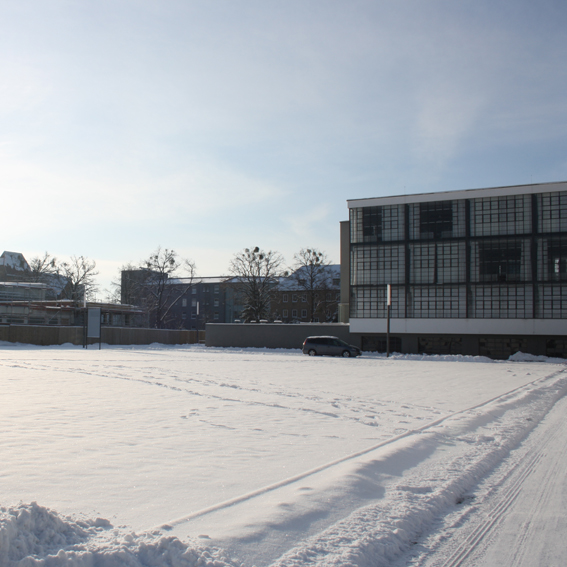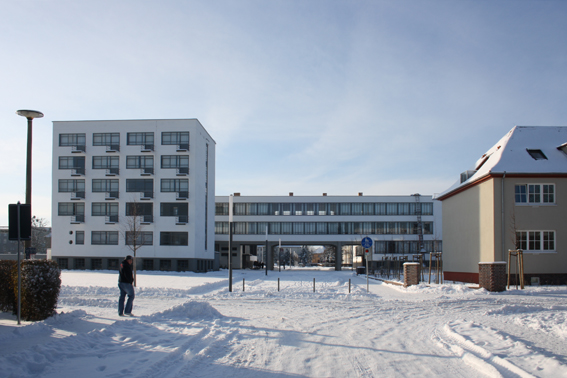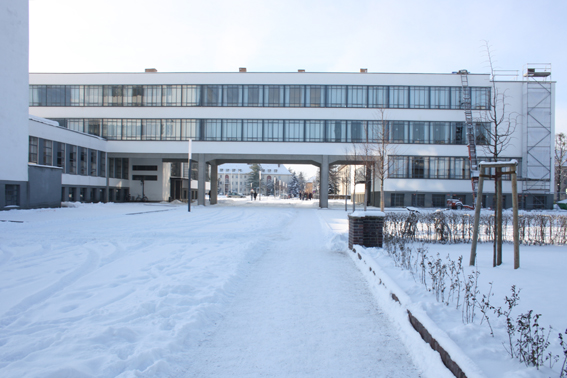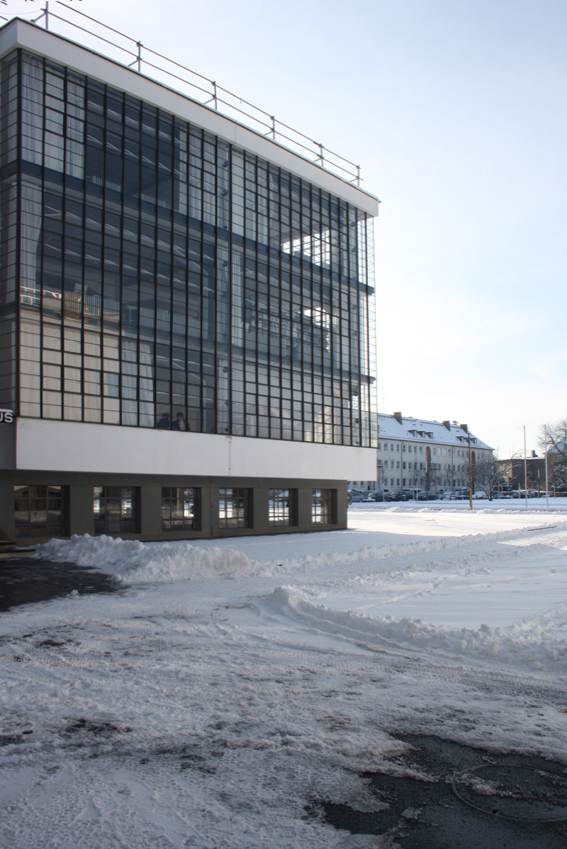One winter morning at Bauhaus
The history of theBauhaus is quite known since it is a living testimony of the historyof Modern architecture. That said, I have no interest whatsoever indescribing the history or architectural aspects of the building. Iwill leave that to the Bauhaus Foundation who, I´m sure will do amuch better work then I ever would.
What ismagnificent in buildings is the impression it is able to leave on us,humans, while experiencing it. From immemorial times, buildings haveinspired humans to be brave, to be better, to have faith...even if,for most of those times, it was also serving power purposes the dreamof powerful men to achieve immortality.
Unfortunately thetruth is, most humans don’t experience once the benefits of goodarchitecture in their entire lifetime, which is I think is quite sad.Maybe if this wasn’t the case, the world would be more sensitivetowards the benefits of architecture and this profession wouldn’tbe becoming more of a marketing/branding product than anything else.
In my mind, beforearriving and living in this building, there were several aspects thatmade no sense to me. I mean, architecturally speaking, it follows themain principles of Modern Architecture and certainly the principlesof the Bauhaus; but I am part of the generation who was taught aboutthe achievements but also the failures of modernism so my perspectivewas pretty analytical.
It seemed weird tome, the glazed facades in such a cold region, and how the low Westsunlight should become uncomfortable in sunny days, but above all,how the building imposed itself indifferent to its surroundingsinstead with the arrogance of thinking it could determine the futuregrowth of the new industrial city of Dessau. It was a Modern buildingfallen from the sky in Dessau.
However all ofthat disappeared in a fraction of second, while approaching thebuilding from Gopiusallee and seeing the big letters that ornamentthe South facade. I remember seating on the entrance outside stairsand observing everything, I wanted to make sure I would never forgetthat specific moment because I knew it was a special one, and thereare no photos that can testify that – only your memory.
Sure,sustainability is not one characteristic of that building, but letsface it, I don’t even know if that term existed in 1925-6, and Ican only imagine the heating bill in winter, and yes, in sunny days,the entire glazed windows have to be closed by long black curtains,and the windows opened to allow air circulation and diminishtemperature, but...what a pleasure it is to pull the chains and watchthe pulleysslowly opening the windows in groups of 5 or 6, aclever designed for sure. In fact the entire building is a work ofart or, as Gropius would certainly prefer, a work of industrialmasterpiece – every detail, studied, prototyped and industriallyproduced. Hopefully creating new products for the new industrializedworld.
That got methinking, about how buildings affect us. What exactly touches ourhearts and minds? I believe it is passion, principles. There isnothing more empty to me than a building that was designed to be“beautiful”, or “sustainable”, or “suitable” - it soundsunfair, I know, but I believe that happens because architecture isnot about one thing, one characteristic, one goal; it is aboutprinciples, that go far beyond the building itself. I couldn’tunderstand the Bauhaus building, because, I hadn’t been there, somy analysis was pragmatic and analytical, but the design of thebuilding wasn’t analytical, it is the dream of a men, of ageneration, that had firm believes on how society would change andhow they could help shaping that society.
EIther they failedor not, it doesn’t matter, because the building testifies theirbelieves, not just a simple sum of things or problems to be solvedand that makes all the difference – it is the difference betweenarchitecture and construction. And anyone can feel that, ittranspires from the building wether you are an architect or not.
Curiously enough,a paradox is created, even if I loved the spring time at the Bauhaus,where you can sit in the grass for long hours, my favorite time isdefinitely winter, when the building appears to be more unsuitable –the white, grey and black building, surrounded by snow in a clearblur sky background seems to enhance its features, almost like amodel, it looks surreal, ethereal...
What ismagnificent in buildings is the impression it is able to leave on us,humans, while experiencing it. From immemorial times, buildings haveinspired humans to be brave, to be better, to have faith...even if,for most of those times, it was also serving power purposes the dreamof powerful men to achieve immortality.
Unfortunately thetruth is, most humans don’t experience once the benefits of goodarchitecture in their entire lifetime, which is I think is quite sad.Maybe if this wasn’t the case, the world would be more sensitivetowards the benefits of architecture and this profession wouldn’tbe becoming more of a marketing/branding product than anything else.
In my mind, beforearriving and living in this building, there were several aspects thatmade no sense to me. I mean, architecturally speaking, it follows themain principles of Modern Architecture and certainly the principlesof the Bauhaus; but I am part of the generation who was taught aboutthe achievements but also the failures of modernism so my perspectivewas pretty analytical.
It seemed weird tome, the glazed facades in such a cold region, and how the low Westsunlight should become uncomfortable in sunny days, but above all,how the building imposed itself indifferent to its surroundingsinstead with the arrogance of thinking it could determine the futuregrowth of the new industrial city of Dessau. It was a Modern buildingfallen from the sky in Dessau.
However all ofthat disappeared in a fraction of second, while approaching thebuilding from Gopiusallee and seeing the big letters that ornamentthe South facade. I remember seating on the entrance outside stairsand observing everything, I wanted to make sure I would never forgetthat specific moment because I knew it was a special one, and thereare no photos that can testify that – only your memory.
Sure,sustainability is not one characteristic of that building, but letsface it, I don’t even know if that term existed in 1925-6, and Ican only imagine the heating bill in winter, and yes, in sunny days,the entire glazed windows have to be closed by long black curtains,and the windows opened to allow air circulation and diminishtemperature, but...what a pleasure it is to pull the chains and watchthe pulleysslowly opening the windows in groups of 5 or 6, aclever designed for sure. In fact the entire building is a work ofart or, as Gropius would certainly prefer, a work of industrialmasterpiece – every detail, studied, prototyped and industriallyproduced. Hopefully creating new products for the new industrializedworld.
That got methinking, about how buildings affect us. What exactly touches ourhearts and minds? I believe it is passion, principles. There isnothing more empty to me than a building that was designed to be“beautiful”, or “sustainable”, or “suitable” - it soundsunfair, I know, but I believe that happens because architecture isnot about one thing, one characteristic, one goal; it is aboutprinciples, that go far beyond the building itself. I couldn’tunderstand the Bauhaus building, because, I hadn’t been there, somy analysis was pragmatic and analytical, but the design of thebuilding wasn’t analytical, it is the dream of a men, of ageneration, that had firm believes on how society would change andhow they could help shaping that society.
EIther they failedor not, it doesn’t matter, because the building testifies theirbelieves, not just a simple sum of things or problems to be solvedand that makes all the difference – it is the difference betweenarchitecture and construction. And anyone can feel that, ittranspires from the building wether you are an architect or not.
Curiously enough,a paradox is created, even if I loved the spring time at the Bauhaus,where you can sit in the grass for long hours, my favorite time isdefinitely winter, when the building appears to be more unsuitable –the white, grey and black building, surrounded by snow in a clearblur sky background seems to enhance its features, almost like amodel, it looks surreal, ethereal...
























